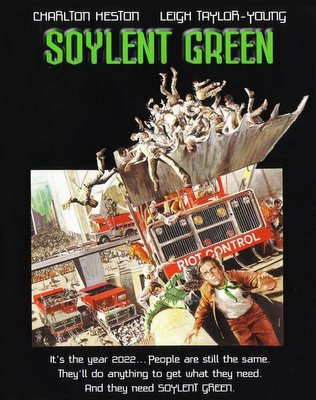 Soylent Green
Soylent Green The movie, set in the year 2022, depicts a future dystopia, a Malthusian catastrophe that takes place because humanity has failed to pursue sustainable development and has not halted population growth. Global warming and air and water pollution have produced a year-round heatwave, food and fuel resources are scarce, housing is dilapidated and overcrowded, and widespread government-sponsored euthanasia is encouraged as a means of reducing overpopulation. Charlton Heston plays Robert Thorn, a New York City police detective, investigating the suspicious murder of William R. Simonson (Joseph Cotten), a former member of the board of the Soylent Corporation. Thorn's roommate is Sol Roth (Edward G. Robinson), a onetime college professor who is an elderly police researcher.
In the movie, meat, bread, cheese, fruit and vegetables are scarce and extremely expensive, and the government dispenses rations of synthetic food substances made by the Soylent Corporation: Soylent Yellow, Soylent Red, and the newest product, Soylent Green, the most popular version. As the name suggests, Soylent is derived from soybeans and lentils.
However, during his investigation of the Simonson murder, Thorn uncovers a strange conspiracy, which will be revealed if he sees what goes on behind closed doors at the euthanasia centers. When an elderly and dispirited Sol opts for euthanasia, Thorn forces his way in to the euthansia center at gunpoint and makes two shocking discoveries. First, he sees films of the unspoiled Earth of former times, which are shown only to those about to be euthanized. He is startled to see how beautiful the Earth was before it sank to its current state.
Now we roll up todays senario:
US may press Africa on GMOs
Reuters - Wed Feb 8, 10:35 AM ET
LUSAKA - The U.S. may push Africa to accept gene-altered (GMO) food now that the World Trade Organization (WTO) has ruled the EU broke rules by barring GMO foods and seeds, but Africans vowed on Wednesday to resist. "We do not want GM (genetically modified) foods and our hope is that all of us can continue to produce non-GM foods," Zambian Agriculture Minister Mundia Sikatana told Reuters in Lusaka. "The decision by the WTO does nothing to change our stand in this matter."
GM food: What the fuss is all about
GENEVA (AFP) - In Mesopotamia about 5,000 years ago, there occurred one of the biggest events in human history: Homo sapiens discovered that by penning animals and growing crops, he no longer had to hunt for food or gather it. Until a handful of years ago, the way in which our ancestors improved food species remained fundamentally unchanged over the millennia. Through splicing and cross-breeding, farmers introduced new genes into plants and animals in order to boost the yield.
This time-honoured method led to IR8, the rice plant which drove the Green Revolution that staved off famine in South Asia in the 1960s. And it gave us the cows, pigs and chickens of today which deliver more milk, beef, ham and eggs than ever before.
(more)
Two kinds of modification characterize this first generation of GM crops.
One is to insert genes to make field crops resistant to a specific herbicide, which means that the farmer can easily spray that weedkiller without also killing the crop.
The other is to put in genes that cause the plant to exude a toxin that kills insect pests, such as the corn borer, which attacks corn plants.
You don't understand... I've seen it. I've seen it happening. The ocean is dying, the plankton is dying... It's people! Soylent Green is made out of people. They're making our food out of people. Soon, they'll be breeding us like cattle -- for food! You gotta tell 'em! Listen to me, Hatcher! You gotta tell 'em -- SOYLENT GREEN IS PEOPLE!!! We gotta stop them! Somehow! Listen! Listen to me... PLEASE!!!
No words necessary on this one folks...
Naro%
